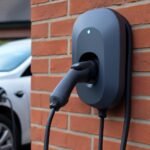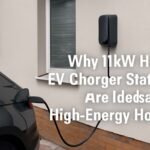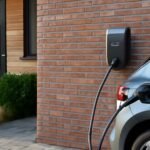In the rapidly growing electric vehicle (EV) market, the demand for reliable and safe charging solutions is paramount. As more electric vehicles hit the road, the need for efficient, durable, and secure EV charging stations becomes increasingly important. AC 11kW EV chargers have emerged as a popular choice for both residential and commercial charging stations due to their optimal performance, cost-efficiency, and ease of use. However, one of the most critical factors influencing the adoption of 11kW AC chargers is safety. OEM manufacturers play a pivotal role in integrating safety features into these chargers, ensuring that users can enjoy a hassle-free and secure charging experience.
In this article, we’ll explore how OEM manufacturers integrate AC safety into 11kW EV chargers and what safety standards and features buyers should be looking for when sourcing these charging solutions.
Table of Contents
Understanding the Importance of AC Safety in 11kW EV Chargers
Before diving into the specifics of OEM integration of AC safety features, it’s essential to understand why safety is so critical in 11kW EV chargers. These charging stations operate at high power levels, which can present potential risks if not adequately managed. Factors such as overheating, electrical surges, and short circuits can cause damage to the vehicle’s battery or pose a safety hazard to users. Additionally, compliance with regional safety regulations is a must to ensure the charging infrastructure is safe, reliable, and legally approved.
For OEM manufacturers, designing a safe 11kW AC charger involves a comprehensive understanding of electrical systems and safety protocols to mitigate these risks.
Key Safety Features Integrated by OEM Manufacturers
Overcurrent Protection Overcurrent protection is one of the most critical safety features in any electrical appliance, including EV chargers. An overcurrent event can occur when the current flowing through the charger exceeds its design capacity, potentially damaging both the charger and the vehicle’s battery.
OEM manufacturers typically incorporate overcurrent protection mechanisms such as circuit breakers or fuses in their 11kW AC chargers. These devices immediately disconnect the power supply when excessive current is detected, preventing any electrical damage or fire hazards.
Ground Fault Protection Ground faults happen when an unintended path is formed, allowing electricity to flow to the ground. This could be due to a malfunction or insulation breakdown within the charging unit.
To prevent accidents, OEM manufacturers often integrate ground fault detection and protection circuits. These systems detect any leakage of current to the ground and automatically shut off the charger to avoid electrocution hazards or fire risks.
Temperature Monitoring and Overheat Protection High-power charging generates heat, and if the temperature of the charging unit exceeds safe limits, it can lead to thermal damage to internal components or even a fire.
To mitigate this risk, OEM manufacturers equip 11kW AC chargers with thermal sensors and overheat protection systems. These sensors continuously monitor the temperature of the charger’s components, and if it exceeds a predefined threshold, the charger will either reduce power output or shut down entirely to prevent overheating.
Short-Circuit Protection Short circuits can occur if a direct connection forms between the positive and negative terminals of a charger, leading to a sudden surge of current that could cause damage.
Short-circuit protection is integrated by OEM manufacturers through specialized components like relays and circuit breakers. These automatically disconnect the charger in case a short circuit is detected, thus preventing any electrical damage.
Surge Protection Power surges, which can be caused by lightning strikes, electrical grid instability, or other external factors, can cause significant harm to sensitive electronics in EV chargers. OEM manufacturers incorporate surge protection devices (SPDs) in their 11kW AC chargers to safeguard against these high-voltage spikes. These devices absorb and redirect excess voltage, protecting both the charger and the vehicle.
IP Rating for Weather Resistance Many 11kW AC EV chargers are installed outdoors, exposed to various weather conditions. To protect against water and dust ingress, OEM manufacturers often design chargers with an appropriate Ingress Protection (IP) rating. A higher IP rating (e.g., IP65 or IP66) ensures that the charger remains operational even in harsh environments, preventing water or dust from interfering with its internal components and compromising safety.
Compliance with International Standards and Certifications
OEM manufacturers must also ensure their AC 11kW EV chargers comply with international safety standards and certifications. These standards provide a framework for ensuring that chargers meet specific safety criteria before they can be sold or installed.
IEC 61851-1: This standard covers the safety requirements for electric vehicle conductive charging systems. It includes guidelines for the electrical, mechanical, and environmental safety of chargers, ensuring that the unit performs safely under normal and fault conditions.
CE Marking: The CE mark indicates that the product conforms to European Union safety, health, and environmental protection standards. For 11kW AC chargers to be sold in Europe, they must bear this mark, signifying compliance with relevant EU directives.
UL Certification: For markets such as the United States, OEM manufacturers may seek UL certification for their 11kW EV chargers. UL certification demonstrates that the product has passed rigorous safety tests, including those for electrical safety, fire hazards, and other potential risks.
TÜV Rheinland Certification: This certification is particularly important in Europe, as it confirms that a product meets the highest safety and quality standards. Many OEM manufacturers work with TÜV Rheinland to ensure their 11kW AC chargers adhere to European safety regulations.
The Role of OEM Manufacturers in Ensuring Long-Term Reliability
While the integration of safety features is crucial, OEM manufacturers also focus on the long-term reliability of the 11kW AC chargers. This is achieved through:
Robust Testing: OEM manufacturers conduct extensive tests on their chargers under various conditions to ensure they perform safely and efficiently over their entire lifespan.
Component Quality: By using high-quality materials and components, manufacturers ensure that the charger can withstand wear and tear without compromising safety.
Regular Firmware Updates: Some manufacturers provide regular firmware updates to enhance safety features, ensuring that chargers remain protected against evolving risks.
Conclusion
When sourcing 11kW AC EV chargers, European buyers should prioritize OEM manufacturers who integrate comprehensive safety features, adhere to international standards, and deliver long-term reliability. By ensuring that the chargers are equipped with overcurrent protection, ground fault detection, temperature monitoring, short-circuit protection, surge protection, and weather resistance, OEM manufacturers help mitigate the potential risks associated with high-power charging. Furthermore, certifications like CE, UL, and TÜV Rheinland add an extra layer of confidence, demonstrating that the chargers meet strict safety regulations.
As the demand for EV charging infrastructure continues to rise, OEM manufacturers will play a crucial role in shaping the safety and performance of 11kW AC chargers, enabling a secure and sustainable future for electric vehicle owners.



